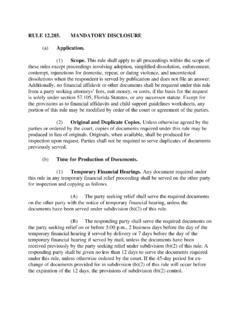Transcription of Periods List (Historic England) - FISH
1 Periods List (Historic England). List of the main archaeological and cultural Periods of Britain. May vary compared to other period lists, this one has been developed by Historic England. Name Description Max Min date date Palaeolithic The period once referred to as the Old Stone Age. It is defined by the practice of hunting and gathering and the use of chipped flint tools. This period is usually divided up into the Lower, Middle and Upper Palaeolithic. -10000 -500000. Lower Palaeolithic The earliest subdivision of the Palaeolithic, or Old Stone Age; when the earliest use of flint tools appears in the current archaeological record.
2 A hunter gatherer society is a defining characteristic. -150000 -500000. Middle Palaeolithic The second subdivision of the Palaeolithic or Old Stone Age. Characterized by the fine flake tools of the Mousterian tradition and economically by a hunter gatherer society. -40000 -150000. Upper Palaeolithic The third and last subdivision of the Palaeolithic or Old Stone Age; characterized by the development of projectile points made from bony materials and the development of fine blade flint tools. -10000 -40000. Mesolithic The Middle Stone Age, falling between the Palaeolithic and the Neolithic; marks the beginning of a move from a hunter gatherer society towards food producing society.
3 -4000 -10000. Early Mesolithic The earliest subdivision of the Mesolithic, or Middle Stone Age. -7000 -10000. Late Mesolithic The latest subdivision of the Mesolithic, or Middle Stone Age. -4000 -7000. Early Prehistoric For monuments which are characteristic of the Palaeolithic to Mesolithic but cannot be specifically assigned. -4000 -500000. Neolithic The New Stone Age, this period follows on from the Palaeolithic and the Mesolithic and is itself -2200 -4000. succeeded by the Bronze Age. This period is characterized by the practice of a farming economy and extensive monumental constructions.
4 Early Neolithic The earliest subdivision of the Neolithic, or New Stone Age. -3300 -4000. Middle Neolithic The second subdivision of the Neolithic, or New Stone Age. -2900 -3300. Late Neolithic The third and latest subdivision of the Neolithic, or New Stone Age. -2200 -2900. Bronze Age This period follows on from the Neolithic and is characterized by the increasing use of Bronzework. It is subdivided in the Early, Middle and Late Bronze Age. -700 -2600. Early Bronze Age The earliest subdivision of the Bronze Age.
5 -1600 -2600. Middle Bronze Age The second subdivision of the Bronze Age. -1200 -1600. Late Bronze Age The third and latest subdivision of the Bronze Age. -700 -1200. Iron Age This period follows on from the Bronze Age and is characterized by the use of iron for making tools and monuments such as hillforts and oppida. The Iron Age is taken to end with the Roman invasion. 43 -800. Early Iron Age The earliest subdivision of the Iron Age. -300 -800. Middle Iron Age The second subdivision of the Iron Age. -100 -300. Late Iron Age The third and latest subdivision of the Iron Age.
6 43 -100. Late Prehistoric For monuments that can be identified only to a date range from Neolithic to Iron Age. 43 -4000. Prehistoric For monuments that can be identified only to a date range from Palaeolithic to Iron Age. 43 -500000. Roman Traditionally begins with the Roman invasion in 43AD and ends with the emperor Honorius directing Britain to see to its own defence in 410AD. 410 43. Early Medieval This dates from the breakdown of Roman rule in Britain to the Norman invasion in 1066 and is to be used for monuments of post Roman, Saxon and Viking date.
7 1066 410. Medieval The Medieval period or Middle Ages begins with the Norman invasion and ends with the dissolution of the monasteries. 1540 1066. Post Medieval Begins with the dissolution of the monasteries and ends with the death of Queen Victoria. Use more specific period where known. 1901 1540. Tudor Dating to the reign of the Tudor monarchs. 1603 1485. Elizabethan Dating to the reign of Elizabeth 1st of England. 1603 1558. Stuart Dating to the reign of the Stuart kings of England (including the Commonwealth inter-regnum).
8 1714 1603. Jacobean Dating to the reign of James I of England (VI of Scotland). 1625 1603. Hanoverian Dating to the reign of the Hanoverian kings. 1837 1714. Georgian Dating to or characteristic of the reigns of any of the first four kings of Great Britain called George. 1830 1714. Victorian Dating to the reign of Queen Victoria. 1901 1837. 20th Century Previously recorded as 'Modern'. 2000 1901. Early 20th Century The first third of the 20th century. 1932 1901. Edwardian The period covering the reign of Edward VII.
9 Do not use for the reigns of Edwards I-VI. 1910 1902. First World War Used to record buildings, defensive monuments and sites dating to, and associated with, the First World War. For other types of building, such as houses, built during this period use EARLY. 20TH CENTURY. 1918 1914. Mid 20th Century The mid third of the 20th Century. 1966 1933. Second World War Used to record buildings, defensive monuments and sites dating to, and associated with, the Second World War. For other types of building, such as houses, built during this period use MID.
10 20TH CENTURY. 1945 1939. Late 20th Century The final third of the 20th century. 2000 1967. Cold War The period of political and military opposition between the major Superpowers (USA and USSR). and their allies. Known as the Cold War as there were no direct military conflicts between the two main protagonists. 1991 1946. 21st Century Twenty first century phases and events. 2100 2001. Uncertain Catch all for uncertain period allocations.


